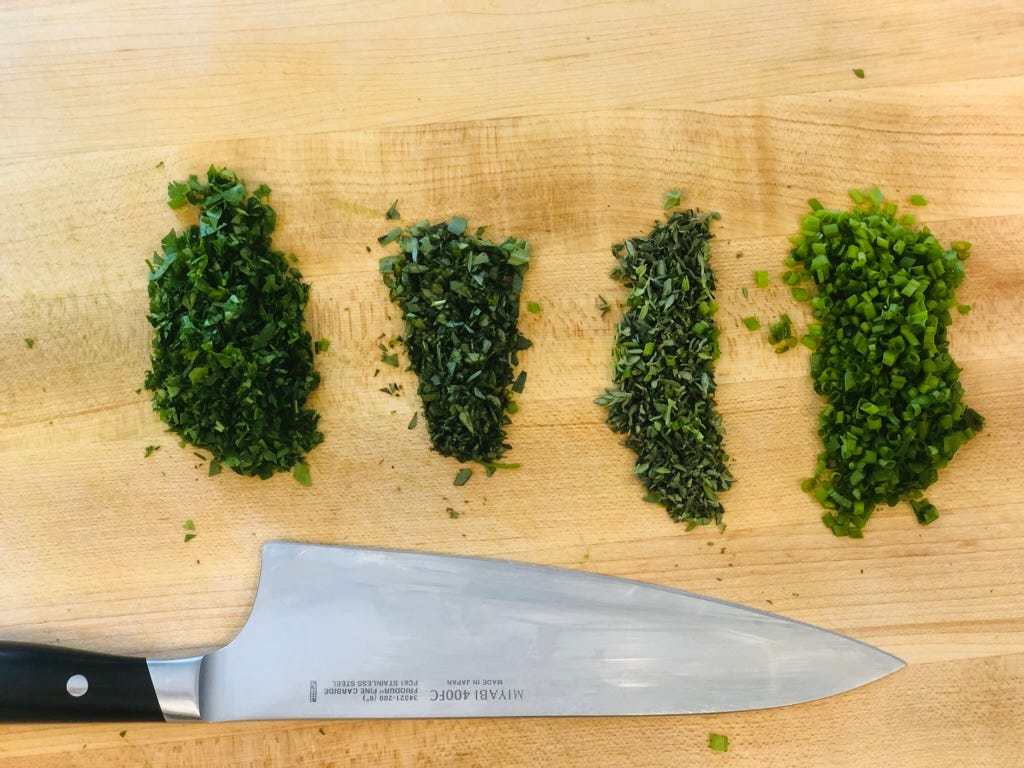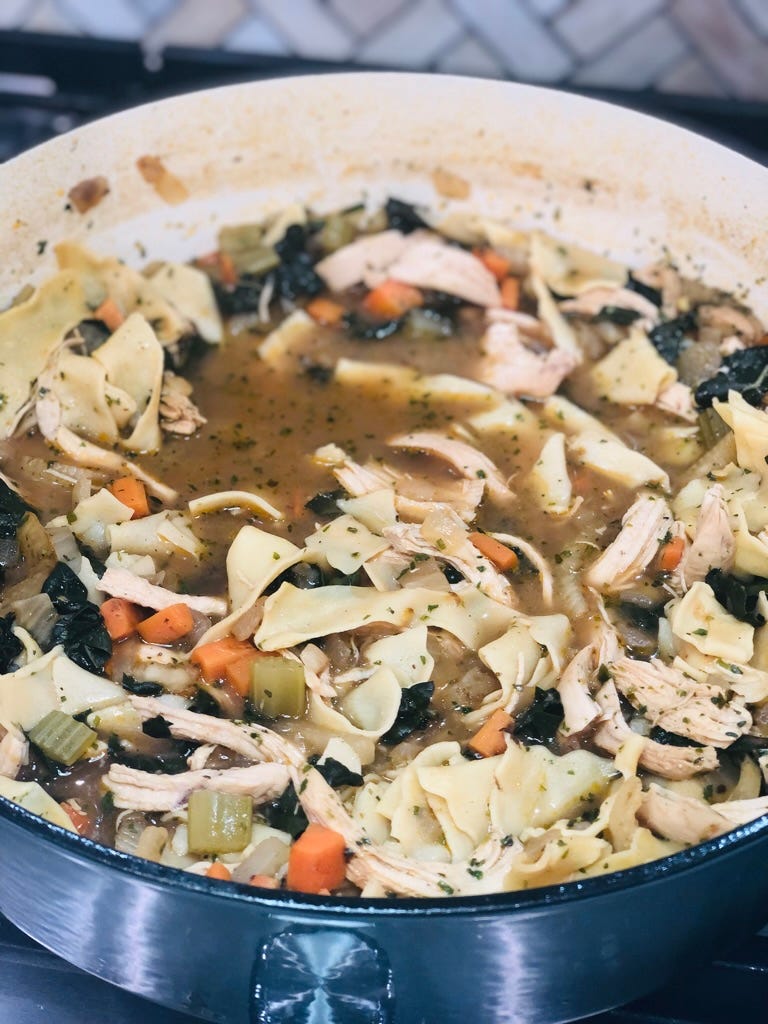Herbs
Notes, no-nos, and next steps...
More likely than not, you’re using your herbs wrong.
That’s because not all herbs should be treated the same way. There are different types of herbs with different properties which affect how they should be prepared, stored, and added to food.
The word “herb” is Latin for grass, and therefore refers to the leaves and stems of a variety of leafy, soft stemmed plants. (Spices, on the other hand, refer to the bark, pods, and seeds of plants).
The two key words here are Leaves and Stems. Herbs generally fall into two categories — Stalk Herbs and Fine Herbs. Stalk Herbs have woody stems and tougher leaves which make them appropriate for longer cooking. Fine Herbs are leafier, and are more fragile, making them more appropriate for shorter cooking. Both can be used fresh or dried.
The point of using herbs is to extract their flavor and aroma from the essential, volatile oils they contain. You unlock these oils through heat (cooking) and handling (cutting).
The biggest mistake most of us make when using herbs is adding them at the wrong time.
Adding fresh, fine, leafy herbs at the beginning of cooking a sauce (say… chopped basil to a tomato sauce) is too early. The leaves just wilt into sorry looking strings, lose their color, and their flavor evaporates. But adding (and later removing) just their tougher stalks early on will infuse the sauce with basil flavor, which is enhanced when you add the fresh chopped (or torn) basil just before serving.
Types Of Herbs
Stalk Herbs
Add early (fresh or dried)
Rosemary
Thyme
Sage
Oregano (see note)
Leafy Herbs
Add late (fresh)
Basil
Cilantro
Parsley (see note)
Tarragon
Mint
Chives
Dill
Fennel
Marjoram
Chervil
A note on fresh vs dried herbs:
Drying herbs strengthens their flavor, but makes them less complex. So dried leafy herbs can be added earlier in the cooking process in order to give them time to develop. The heat releases their oils/flavor.
Fresh leafy herbs are more mild, but far more complex. They add a freshness and spike of immediate flavor to the dish when added late. Adding them too early and that spike dissipates. Heat kills it.
A note on parsley:
All references to parsley are limited to fresh Italian flat-leaf parsley. Dried parsley is garbage. Curly parsley is bitter and used as garnish in chain restaurants only… also garbage.
A note on oregano:
Oregano kinda straddles the line between stalk and leafy herb.
A note on stems:
Leafy herbs have stems, and those stems can be used as stalk herbs. Think basis stems, parsley stems, etc. When you are cutting leafy herbs, the rule of thumb is to remove the leaves from the stem. You don’t want the tough stems mixed in with the delicate leaves when usign the herbs on your dish. But don’t throw away those stems! Use them earlier in the sauce, or save them for a stock.
A note on cutting herbs:
If cutting fresh herbs leaves your board green, something’s wrong. Rather than cutting, your mashing and bruising them. According to chef John — “A small amount of properly treated herbs is more impactful than a cup of mangled ones.” Make sure you knife is sharp, and cut with care.
Storing Herbs
In the summer, I’m spoiled because I grow a lot of herbs and just cut them as needed… no storage necessary. Most are super easy to grow, so my biggest suggestion is to grab a hand trowel and a watering can and get after it.
But in the winter, fresh herbs means buying them in shitty plastic containers from King Soopers and then IMMEDIATELY GETTING THEM OUT OF THE PACKAGING unless you want a plastic clamshell full of mold in two days.
I wish I could tell you that this was as simple as storing leafy herbs one way and stalky herbs another way. I also wish I could tell you that I had the patience, interest, and discipline to look up how each herb should be properly stored. But it’s not, and I don’t, so I’ll just provide a small smattering of the more common methods I’ve used with success.
Parsley and Tarragon: Store in a container w/ about an inch of water, covered in a plastic bag, in the fridge.
Chives and Thyme: Wrap stems in a damp paper towel and store in a ziploc with all the air pressed out. (Or mince them fine and combine them w/ butter and freeze. Herb butter is the bomb when making omelets, or on a grilled steak).
Basil: Store in a container w/ about an inch of water OUT of the fridge (preferably w/ some light), uncovered.
If you do have herbs that are close to going off, make a quick oil from them. Simply puree in equal parts herb/oil. Keeps for a good month. Basil oil is a great condiment to have on hand for nearly anything.
Fines Herbs
Pronounced “Feens Herbs” this is a classic French herb blend with a host of uses worth knowing. The other is Herbs de Provence, which you can easily get dried in jars. But fines herbs in my opinion is best fresh, so you gotta make it yourself.
It’s pretty simple… mince equal parts parsley, chives, tarragon, and chervil and combine. Done. The hardest part is finding chervil in the store. Substitutions can include fennel frond (which has a similar anise-like flavor), thyme leaves, or just skip it altogether.
It’s great for finishing omelets, adding to salads, sprinkling on roast chicken, and more.
Since a I got a request for adding recipe examples, here’s a quick non-recipe recipe for how I’ve been enjoying fines herbs that combines some of the concepts I’ve written about so far:
Chicken Noodle Soup with Fines Herbs
Make about mirepoix (about 2 cups). Medium dice.
When soft, add 1 tbl tomato paste and let caramelize a bit.
Add 2 chicken breasts (bone in/out doesn’t matter)
Cover with water or stock and let simmer. (This basically creates the broth.)
When the broth looks good (ie: like a broth… about a half hour) remove chicken.
If using dried pasta, add about a cup to the broth now and let simmer.
While soup simmers, let chicken cool, then shred into pieces
Add chicken pieces back to soup.
If using fresh pasta, or leftover cooked pasta, add now.
Once pasta is cooked (10-12 min for dried pasta, 3 min for fresh/leftover pasta), add a tablespoon or so of fines herbs.
Salt generously and then taste.
For fun, salt and taste before the fines herbs, then again after the fines herbs, and note the flavor difference the fines herbs adds.
—
Read all previous posts on the Cooked/Uncooked website here.
No need to download the app.



